Caryn
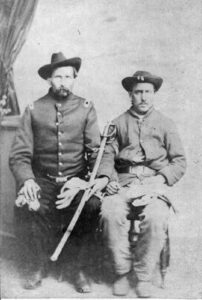
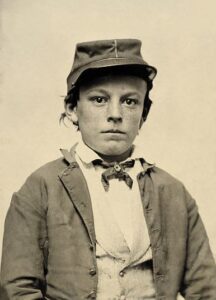 Anyone who has studied history in school knows about the Civil War. It was, of course, fought over slavery. The South wanted to keep the slaves and the North wanted to free the slaves. The Civil War was unique in another way too. Most wars are fought with soldiers who are rough and tough, ready to take on the elements, and battle to the death for their cause. The Civil War was that too, but the men of the South during the Civil War Era, were part of an era of the southern belles and southern gentlemen. This was an era when a type of lifestyle was borrowed from the English countryside, and basically transplanted into the American south. The lifestyle included a glorification of elegant horse riding, hunting, and of course, etiquette. This era and the people in it felt like there was a proper way to do things and that a certain level of decorum must be kept at all costs, in order to preserve their way of life.
Anyone who has studied history in school knows about the Civil War. It was, of course, fought over slavery. The South wanted to keep the slaves and the North wanted to free the slaves. The Civil War was unique in another way too. Most wars are fought with soldiers who are rough and tough, ready to take on the elements, and battle to the death for their cause. The Civil War was that too, but the men of the South during the Civil War Era, were part of an era of the southern belles and southern gentlemen. This was an era when a type of lifestyle was borrowed from the English countryside, and basically transplanted into the American south. The lifestyle included a glorification of elegant horse riding, hunting, and of course, etiquette. This era and the people in it felt like there was a proper way to do things and that a certain level of decorum must be kept at all costs, in order to preserve their way of life.
Tobacco played the central role in defining social class, local politics, and the labor system. In fact, it shaped the entire life of the region, and in doing so, actually shaped the Civil War. While the Civil War was a war, somehow the men of the South who fought in it felt like it needed to have that high level of decorum and decency. Tradition needed to be kept and carried on and while they knew that they were fighting a war, I’m not entirely sure that they understand that there would be, by necessity, loss of life and loss of that decorum and etiquette. For the men of the South especially, the Civil War was one of the most devastating events to challenge their way of life. This was also the most devastating event ever to occur on North American soil. While the loss of life was great, and in fact the Civil War caused more Americans to lose their lives than both World War I and World War II combined, the people of the South lost much of that “British Countryside” lifestyle that they thought so essential…and afterward, they didn’t quite know how to recover from that. The Confederate Army wanted to separate from the Union and maintain slavery, and the fight to combat that notion didn’t end until 1865. The differing ideas were a cause for rift long after the war was over.
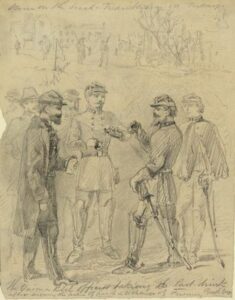
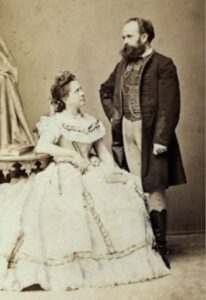 Nevertheless, despite the high stakes, the American soldiers from both sides still had several unofficial truces. Wars are usually long and tedious, and sometimes the men just needed to stop the fighting for a short time and try to be human again. Although these unofficial truces or ceasefires were usually frowned upon by military superiors, the men on either side would frequently call truces at the frontlines so Union and Confederate soldiers could chat, share information, and trade smokes. Imagine that…as the fighting is heavy, someone yells, “Wait…Smoke Break!!” Then both sides would stop shooting, walk out to the middle of te battlefield, and everyone would light a cigarette. I’m sure that’s not exactly how it happened, but they did actually hold such unofficial truces at times.
Nevertheless, despite the high stakes, the American soldiers from both sides still had several unofficial truces. Wars are usually long and tedious, and sometimes the men just needed to stop the fighting for a short time and try to be human again. Although these unofficial truces or ceasefires were usually frowned upon by military superiors, the men on either side would frequently call truces at the frontlines so Union and Confederate soldiers could chat, share information, and trade smokes. Imagine that…as the fighting is heavy, someone yells, “Wait…Smoke Break!!” Then both sides would stop shooting, walk out to the middle of te battlefield, and everyone would light a cigarette. I’m sure that’s not exactly how it happened, but they did actually hold such unofficial truces at times.
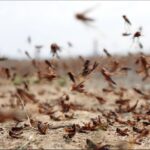
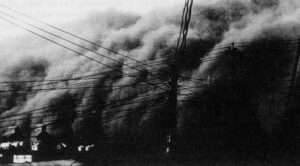 No matter where you live, I’m sure you have had encounters with grasshoppers. They are an unfortunate fact of life in this world. Some years are worse than others, and some areas are worse than others too. There are a few facts about grasshoppers that I didn’t know about, and some I did. Unfortunately, there are no chemical pesticides to control grasshoppers, but since cool, moist conditions slow them down and encourage the growth of fungi (which cause disease in grasshoppers), keeping plant beds moist and well irrigated may help ward them off. To protect small areas, try using a sticky paper or screening. Most of us find that in dry hot years, the grasshoppers make us as miserable as the heat. Never was that more evident than on July 26, 1931, when a swarm of grasshoppers descended on crops throughout America’s heartland, devastating millions of acres. Iowa, Nebraska, and South Dakota were already suffering from a bad drought that brought severe damage to the crops in the region. The grasshoppers really just finished them off.
No matter where you live, I’m sure you have had encounters with grasshoppers. They are an unfortunate fact of life in this world. Some years are worse than others, and some areas are worse than others too. There are a few facts about grasshoppers that I didn’t know about, and some I did. Unfortunately, there are no chemical pesticides to control grasshoppers, but since cool, moist conditions slow them down and encourage the growth of fungi (which cause disease in grasshoppers), keeping plant beds moist and well irrigated may help ward them off. To protect small areas, try using a sticky paper or screening. Most of us find that in dry hot years, the grasshoppers make us as miserable as the heat. Never was that more evident than on July 26, 1931, when a swarm of grasshoppers descended on crops throughout America’s heartland, devastating millions of acres. Iowa, Nebraska, and South Dakota were already suffering from a bad drought that brought severe damage to the crops in the region. The grasshoppers really just finished them off.
Anyone who has grown a garden, crops, trees, and even grass, have struggled to prevent insects from eating their crops or plants. Locusts and grasshoppers, which are insect cousins, are among the most feared pests. If the conditions are right, their populations can suddenly explode, and while just their presence is enough to make most people’s skin crawl, the speed with which they are able to eat through a field of crops is impossible to comprehend, unless they have witnessed it for themselves. A plague of these insects occurs when drought conditions cause their populations to suddenly explode. The egg pods don’t do well in wet conditions, so when the soil is very dry, swarms can develop. “They explode from beneath your feet. There’s sort of a rolling wave that forms out in front of you. They hit up against your body and cling against your clothes. It’s almost like being immersed in a gigantic living being,” says Professor Jeff Lockwood of Wyoming.
The swarm in July of 1931 was so thick that it actually blocked out the sun. The grasshoppers had to be scooped up with a shovel. They ate the cornstalks down to the ground, leaving just stubs, and they ate 
 everything in the fields, down to the bare ground. Thankfully, the United States hasn’t seen swarms since the early 1930s. Many other areas of the world are not so fortunate. North Africa and parts of the Middle East continue to experience problems with insect swarms. In fact, the swarms in some of those areas have involved as many as a billion bugs. I don’t know about you, but now my skin is really crawling. Eeeeeeewwwwwwww!!
everything in the fields, down to the bare ground. Thankfully, the United States hasn’t seen swarms since the early 1930s. Many other areas of the world are not so fortunate. North Africa and parts of the Middle East continue to experience problems with insect swarms. In fact, the swarms in some of those areas have involved as many as a billion bugs. I don’t know about you, but now my skin is really crawling. Eeeeeeewwwwwwww!!
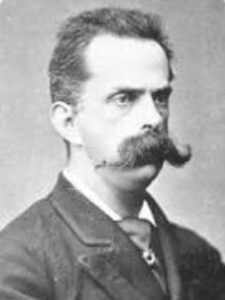 Each year, approximately 40 million lightning strikes hit the ground in the United States, with Tampa, Florida having the most, and Florida being listed as the Lightning Capital of the United States. While Florida is known as the Sunshine State, it is notorious for thunderstorms, lightning strikes and fatalities. On average, Florida has 3,500 cloud to ground lightning flashes per day and 1.2 million flashes per year. Nevertheless, the odds of a human being struck by lightning in a given year are less than one in a million, and strangely, almost 90% of all lightning strike victims survive. The odds of being struck multiple times is even less, with the record being seven times in one lifetime. According to the National Weather Service, lightning causes an average of 62 deaths and 300 injuries in the United States each year. People can be at greater risk for being struck if they participate in outdoor recreational activities or working outside. Regional and seasonal differences can also increase the risk of being struck by lightning. Being outdoors in a lightning storm is certainly not a good idea.
Each year, approximately 40 million lightning strikes hit the ground in the United States, with Tampa, Florida having the most, and Florida being listed as the Lightning Capital of the United States. While Florida is known as the Sunshine State, it is notorious for thunderstorms, lightning strikes and fatalities. On average, Florida has 3,500 cloud to ground lightning flashes per day and 1.2 million flashes per year. Nevertheless, the odds of a human being struck by lightning in a given year are less than one in a million, and strangely, almost 90% of all lightning strike victims survive. The odds of being struck multiple times is even less, with the record being seven times in one lifetime. According to the National Weather Service, lightning causes an average of 62 deaths and 300 injuries in the United States each year. People can be at greater risk for being struck if they participate in outdoor recreational activities or working outside. Regional and seasonal differences can also increase the risk of being struck by lightning. Being outdoors in a lightning storm is certainly not a good idea.
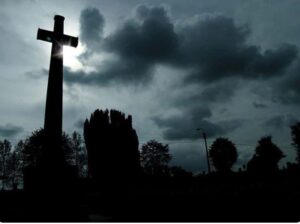
Lightning strikes to humans have been going on as long as times and lightning strikes have been going on. We just hear about them more today than in the distant past. Rarely, humans are struck by lightning, and even with the record of known strikes to humans in one lifetime being seven, it is still a very rare phenomenon. The first time Major Walter Summerford, an Englishman, was said to have been struck by lightning was in 1918 on a World War I battlefield. He was reportedly riding a horse at the time and, while the animal died, Summerford was only temporarily incapacitated by the strike. It’s possible the horse took the bulk of the hit, because Summerford’s feet were not on the ground, meaning that it traveled through Summerford, through the horse, and then on into the ground. That is the nature of lightning. It travels through something with electricity (which humans have, by the way) and then into the ground. So unfortunately, the horse became a part of the connection and actually finished the connection…costing the horse its life. Sad, for sure, but the horse saved the life of its rider.
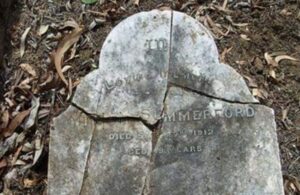
Summerford’s documented additional strikes included two more times…in 1924 and 1930. Then to make him even more unique, Summerford was technically struck after he had died. It happened that two years after he was buried in Vancouver, Canada, a lightning storm went through the area, and lightning actually struck his gravestone in 1936. The bolt was packed with so much power, that Summerford’s gravestone was completely destroyed by that fourth lightning strike. Now that’s got to be the most unique human/lightning encounter story in history.

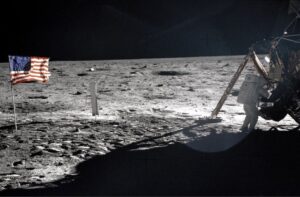 Neil Armstrong made history on July 20, 1969, when he became the first person to step on the moon. That is something we all have known about for a very long time. What we didn’t know about was that the Wright Brothers also made history on the moon. You might wonder how that could be, considering the fact that Orville and Wilber Wright died in 1948 and 1912, respectively. With that many years between their time and the 1969 moon landing, how could the Wright brothers possibly land on the moon. Well, it was simple really. As part of the mission, Armstrong and his team carried small bags of belongings called personal preference kits.
Neil Armstrong made history on July 20, 1969, when he became the first person to step on the moon. That is something we all have known about for a very long time. What we didn’t know about was that the Wright Brothers also made history on the moon. You might wonder how that could be, considering the fact that Orville and Wilber Wright died in 1948 and 1912, respectively. With that many years between their time and the 1969 moon landing, how could the Wright brothers possibly land on the moon. Well, it was simple really. As part of the mission, Armstrong and his team carried small bags of belongings called personal preference kits.
The men were supposed to choose things that had meaning to them and maybe even to the mission they were on. In Armstrong’s bag were souvenirs of another important aircraft… believe it or not, they were parts of the fabric and propeller from the Wright Flyer, flown by Armstrong’s fellow Ohioans, Wilbur and Orville Wright, on December 17, 1903. He must have felt a connection to them since all three of them were from Ohio. Some of those souvenirs remained with Armstrong after the flight to the moon, while some of the others went to the Smithsonian Institution.
In an interesting sidenote, another swatch of fabric from the Wright Flyer went with John Glenn, when he went into orbit aboard the space shuttle Discovery in 1998, and a postage-stamp-size piece has gone to Mars aboard the Ingenuity helicopter. It makes sense that the men who first made flight possible, should somehow have a place in what would have been the future of flight for them, if they were still alive. The Wright brothers started something with that first plane, and it wasn’t just flight. Without that first flight, space travel would never have been possible. They started the ball rolling on an amazing future of space exploration. What mor fitting tribute could there be that to take part of that first plane into space and allow it to land on the moon, mars, or just to be in flight in space at all.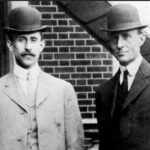
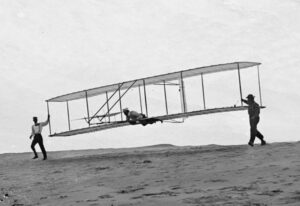
Bringing the Wright brothers into space by proxy was an amazing feat, but there was one other thing that I found odd anyway. When they mission returned home, they actually had to go through customs. That whole thought made me laugh. I mean…what did they think was going to be “smuggled” in, anyway? Nevertheless, going through customs was a requirement, so customs it was.

 My grandniece, Siara Olsen met Chris Kirk in early September of 2021, when she boldly went up to him in the local Loaf and Jug convenience store in Casper, and told him that she liked his freckles. She started calling him her “Loaf and Jug Boyfriend” that very day. How could he resist that?? The year prior had been the hardest year Siara had ever faced, and when she met Chris, her joy returned. She once again became the happy girl we had always known and missed very much. I won’t go into the sadness of the prior year, because this story has a happy ending, and I will focus on that. Chris has the ability to put a smile on my grandniece’s face, and in my book that makes him a great guy. Chris fits well into Siara’s family, and she fits well into his. Theirs is going to be a wonderful and exciting future.
My grandniece, Siara Olsen met Chris Kirk in early September of 2021, when she boldly went up to him in the local Loaf and Jug convenience store in Casper, and told him that she liked his freckles. She started calling him her “Loaf and Jug Boyfriend” that very day. How could he resist that?? The year prior had been the hardest year Siara had ever faced, and when she met Chris, her joy returned. She once again became the happy girl we had always known and missed very much. I won’t go into the sadness of the prior year, because this story has a happy ending, and I will focus on that. Chris has the ability to put a smile on my grandniece’s face, and in my book that makes him a great guy. Chris fits well into Siara’s family, and she fits well into his. Theirs is going to be a wonderful and exciting future.
Siara and Chris have so much in common. They are both very athletic, and love doing te same activities. The 
 first pictures I saw of them together, believe it or not, they were doing a couple’s workout, and it was obvious that they were “head over heels” in love with each other. You never saw a picture of them where they weren’t smiling…unless they were making a face for the camera. They love to joke around, and their happiness just flows out of both of them.
first pictures I saw of them together, believe it or not, they were doing a couple’s workout, and it was obvious that they were “head over heels” in love with each other. You never saw a picture of them where they weren’t smiling…unless they were making a face for the camera. They love to joke around, and their happiness just flows out of both of them.
Siara has long been a fitness buff, and Chris either is too, or he has become one since meeting her. They like to go hiking with Siara’s brother, Jake Harman, his wife, Melanie, and their kids, Alice, Izabella, and Jax. A favorite spot is the Bridle Trail on Casper Mountain. I like to say that families should work toward staying fit together, because it makes for a long and happy life. Hiking and hanging out with her brother’s family also gave everyone a chance to get to know Chris, and they all liked him too. Siara is close to her brother and his family, so that was important.

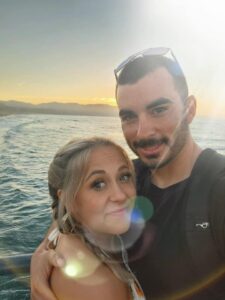
Chris surprised Siara when she had her back to him and he dropped to one knee, just as she turned around. His proposal was sweet and beautiful, and Siara was swept off her feet. I couldn’t say it better than she did, in her own words, “Turning around to you down on one knee asking me if I trust you with my life and my heart it was so easily a yes, but you asking me if I would marry you was the easiest yes of all! Our souls are so deeply connected through God already, but this makes it mean so much more. I love you more than anything, Chris Kirk!” It makes everyone in Siara’s family so happy to see these two tie the knot today. I wish you both all the love and happiness in the world. Congratulations Siara and Chris!! We love you both!!
 My dad, Allen Spencer, went to work for Douglas Aircraft Company on May 19, 1942. He was a young man of just 18 years. Dad wasn’t with Douglas Aircraft Company for very long, because of World War II, and his enlistment in the Army Air Force on March 12, 1943. Nevertheless, the job my dad had while he was at Douglas Aircraft Company would play a big part in his future military assignment as a flight engineer on a B-17 Bomber during World War II, stationed at RAF Great Ashfield in Suffolk, England. Because of Dad’s job there, I have always had an interest in Douglas Aircraft Company.
My dad, Allen Spencer, went to work for Douglas Aircraft Company on May 19, 1942. He was a young man of just 18 years. Dad wasn’t with Douglas Aircraft Company for very long, because of World War II, and his enlistment in the Army Air Force on March 12, 1943. Nevertheless, the job my dad had while he was at Douglas Aircraft Company would play a big part in his future military assignment as a flight engineer on a B-17 Bomber during World War II, stationed at RAF Great Ashfield in Suffolk, England. Because of Dad’s job there, I have always had an interest in Douglas Aircraft Company.
While people might think they don’t know much about Douglas Aircraft Company, they really do, just under a different name. The Douglas Aircraft Company was an American aerospace manufacturer based in Southern California. It was founded in 1921 by Donald Wills Douglas Sr and later merged with McDonnell Aircraft in 1967 to form McDonnell Douglas. With that merger, Douglas Aircraft Company ceased to exist. The name McDonnell Douglas might be a bit more familiar to people, but it was really when McDonnell Douglas merged with Boeing in 1997 that the company became a household name. Everyone has heard of Boeing Aircraft Company.
While Douglas Aircraft Company no longer exists, they made great strides in the aerospace industry during their time in business. One early claim to fame was the first circumnavigation of the world by air in Douglas airplanes in 1924. That was just 21 years after the first powered flight, taken by the Wright Brothers. That may sound like a long time, but to go from the rickety-looking plane the Wright Brothers flew, to something that was 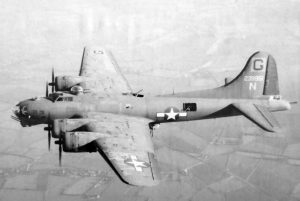 capable of making the flight around the world in just 21 years is truly outstanding. The circumnavigation mission was first presented to Douglas Aircraft Company in 1923, when the US Army Air Service, interested in carrying out a mission to circumnavigate the Earth for the first time by aircraft, approached Douglas Aircraft Company to present it to them. The mission was called “World Flight.” Donald Douglas proposed a modified Douglas DT to meet the Army’s needs. The two-place, open cockpit DT biplane torpedo bomber had previously been produced for the US Navy. The DTs were taken from the assembly lines at the company’s manufacturing plants in Rock Island, Illinois, and Dayton, Ohio, to be modified.
capable of making the flight around the world in just 21 years is truly outstanding. The circumnavigation mission was first presented to Douglas Aircraft Company in 1923, when the US Army Air Service, interested in carrying out a mission to circumnavigate the Earth for the first time by aircraft, approached Douglas Aircraft Company to present it to them. The mission was called “World Flight.” Donald Douglas proposed a modified Douglas DT to meet the Army’s needs. The two-place, open cockpit DT biplane torpedo bomber had previously been produced for the US Navy. The DTs were taken from the assembly lines at the company’s manufacturing plants in Rock Island, Illinois, and Dayton, Ohio, to be modified.
Four of these modified aircraft left Seattle, Washington, on April 6, 1924, flying west, and two of these returned there on September 28 to great fanfare. Unfortunately, one plane had been lost under fog conditions, and another was forced down over the Atlantic and sank. The DWC prototype was then rechristened and joined the other two in completing the North American leg of the flight. With the success of this flight, the Army Air Service ordered six similar aircraft as observation aircraft.
In 1934, Douglas produced a commercial twin-engined transport plane, the Douglas DC-2, which was followed by the famous DC-3 in 1936. The wide range of aircraft produced by Douglas included airliners, light and medium bombers, fighter aircraft, transports, reconnaissance aircraft, and experimental aircraft. While these were all important types of aircraft, it would really be the work they did during World War II, that really put 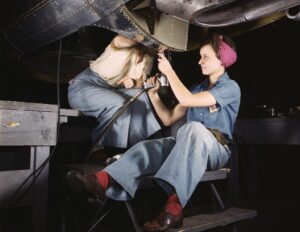 them on the map in my opinion. With so many young men heading off to war, the women really stepped up at this time and built many of the World War II planes. During that time, Douglas joined the BVD (Boeing-Vega-Douglas) consortium to produce the B-17 Flying Fortress. As far as I’m concerned, that was one of the greatest planes every produced. I suppose that sounds odd, considering that it was so long ago, but for its time, the B-17 was and really still is legendary. And while I don’t know if my dad had a part in building the B-17 Bomber, I know that he repaired them and knew them inside and out. I am proud of the work my dad did on the airplanes he helped to build, and proud of his time with Douglas Aircraft Company.
them on the map in my opinion. With so many young men heading off to war, the women really stepped up at this time and built many of the World War II planes. During that time, Douglas joined the BVD (Boeing-Vega-Douglas) consortium to produce the B-17 Flying Fortress. As far as I’m concerned, that was one of the greatest planes every produced. I suppose that sounds odd, considering that it was so long ago, but for its time, the B-17 was and really still is legendary. And while I don’t know if my dad had a part in building the B-17 Bomber, I know that he repaired them and knew them inside and out. I am proud of the work my dad did on the airplanes he helped to build, and proud of his time with Douglas Aircraft Company.

 These days, we have early warning alarms for tornadoes, floods, hurricanes, and even tsunamis, but on July 21, 365, no such warnings existed, not did any kind of measuring tools so we could know the magnitude of the earthquake that caused tsunamis, or the height of the tsunami itself. Nevertheless, it is known that a powerful earthquake off the coast of Greece caused a tsunami that devastated the city of Alexandria, Egypt.
These days, we have early warning alarms for tornadoes, floods, hurricanes, and even tsunamis, but on July 21, 365, no such warnings existed, not did any kind of measuring tools so we could know the magnitude of the earthquake that caused tsunamis, or the height of the tsunami itself. Nevertheless, it is known that a powerful earthquake off the coast of Greece caused a tsunami that devastated the city of Alexandria, Egypt.
In spite of the lack of measuring tools at the time, scientists can now estimate that the earthquake was actually two quakes in quick succession. It is estimated that the largest of those quakes was about a magnitude of 8.0. That magnitude of quake is massive by any standards, and it must have been very scary for anyone who might have felt it. It’s hard to say how many people actually felt it, because of its oceanic location, but even if no one felt the quake, they very much felt the aftereffects of that quake. The really tragic thing was that they had no idea what was coming their way, how very dangerous it was, or even that they should run when they saw it coming. I’m sure that they had seen tides come in and go out, and even storms bringing big wave onto the shore. So, it is very possible that they thought this was not that different than those things, except for it not being time for the tide and there was no storm. They likely just stood there looking at this strange phenomenon, until it took them all out.
The quake was centered near a plate boundary called the Hellenic Arc. Following the quake, a wall of water ran across the Mediterranean Sea toward the Egyptian coast. As happens in tsunamis, the water first recedes, and then comes crashing back. As the water in the harbor receded, ships docked at Alexandria suddenly overturned. As often happens in a disaster, it was reported that many people rushed out to loot the overturned ships. That put even more people in harm’s way. The tsunami wave then rushed in and carried the ships over the sea walls, landing many on top of buildings. The people were trapped, and in Alexandria alone, on that one day, approximately 5,000 people lost their lives, and 50,000 homes were destroyed.
The destruction was even greater in the surrounding villages and towns. Many of these small villages were literally wiped of the face of the earth. Outside of Alexandria, 45,000 people were killed. The salty sea water, inundation the farmlands, rendering them useless for years. From what scientists are able to piece together, the area’s shoreline was permanently changed by the disaster. The tsunami continued on, slowly, but steadily 
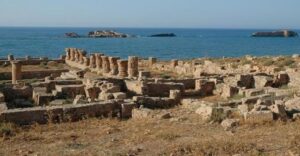 overtaking the buildings of Alexandria’s Royal Quarter. The main reason that the archaeologists learned about this horrific event was that in 1995 that archaeologists actually discovered the ruins of the old city, which lies off the coast of present-day Alexandria. With the changed shoreline following the tsunami, many of the old buildings remained under water for centuries.
overtaking the buildings of Alexandria’s Royal Quarter. The main reason that the archaeologists learned about this horrific event was that in 1995 that archaeologists actually discovered the ruins of the old city, which lies off the coast of present-day Alexandria. With the changed shoreline following the tsunami, many of the old buildings remained under water for centuries.

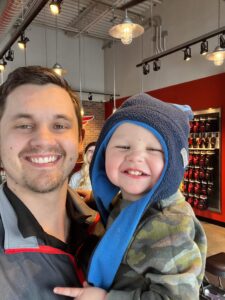 My grandnephew, Dylan Herr who is owner operator of the local Red Wing Shoe store, as well as several in Colorado. Recently, he posted a really cool video showing how work shoe soles are attached to the shoe. I thought the video was quite interesting, and we had a short conversation about it, in which he further explained the process and the fact that while the needle is pretty strong, the needle must be replaced every three days to a week. Then he added that the time frame depends on how good the operator is. I figure they would have to replace the needle several times a day, if they made the mistake of letting me try it, hahahaha!!
My grandnephew, Dylan Herr who is owner operator of the local Red Wing Shoe store, as well as several in Colorado. Recently, he posted a really cool video showing how work shoe soles are attached to the shoe. I thought the video was quite interesting, and we had a short conversation about it, in which he further explained the process and the fact that while the needle is pretty strong, the needle must be replaced every three days to a week. Then he added that the time frame depends on how good the operator is. I figure they would have to replace the needle several times a day, if they made the mistake of letting me try it, hahahaha!!
While Dylan’s business is work shoes, he also likes to play golf. In fact, golf is Dylan’s passion, and he is teaching their 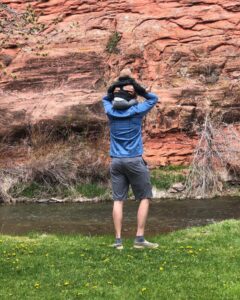
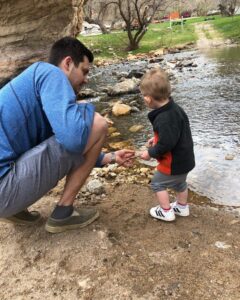 two-year-old son, Max how to play. Dylan’s wife, my grandniece, Katy Herr tells me that Max is getting pretty good, and in fact, Max already has a better swing than she does! Well, I can tell you that Max’s swing would be better than my swing too, because the people behind me are the ones in danger when I try to play golf, hahaha!! Dylan, however, is really good, and he has been playing in a lot of golf tournaments this summer. Dylan has also joined a basketball league this summer through the YMCA. He has really enjoyed that.
two-year-old son, Max how to play. Dylan’s wife, my grandniece, Katy Herr tells me that Max is getting pretty good, and in fact, Max already has a better swing than she does! Well, I can tell you that Max’s swing would be better than my swing too, because the people behind me are the ones in danger when I try to play golf, hahaha!! Dylan, however, is really good, and he has been playing in a lot of golf tournaments this summer. Dylan has also joined a basketball league this summer through the YMCA. He has really enjoyed that.
Dylan and Katy bought a house a while back, and Dylan has been busy taking care of the yard and making their home beautiful. He stained the fence the other day and fixed their garage door that randomly broke the other day! Ahh, the joys of home ownership!! Dylan doesn’t 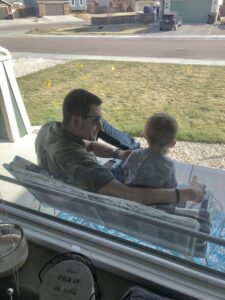
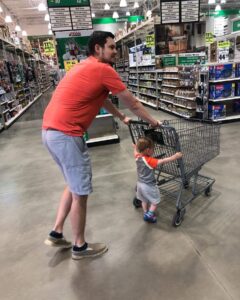 mind the work to make their home nice, because he is a dedicated husband and dad. Dylan loves to take his family out exploring the area, and of course, his son Max is his exploring buddy. They go everywhere together…shopping for home improvement supplies, checking out the rocks near a creek, seeing the beautiful colors of Wyoming, or just hanging out on the front porch. Dylan is also a great husband to Katy. They are so in love and so happy. I love seeing the smiles on their faces. They are a perfect couple…soulmates for sure, and that makes their families very happy too. Today is Dylan’s birthday. Happy birthday Dylan!! Have a great day!! We love you!!
mind the work to make their home nice, because he is a dedicated husband and dad. Dylan loves to take his family out exploring the area, and of course, his son Max is his exploring buddy. They go everywhere together…shopping for home improvement supplies, checking out the rocks near a creek, seeing the beautiful colors of Wyoming, or just hanging out on the front porch. Dylan is also a great husband to Katy. They are so in love and so happy. I love seeing the smiles on their faces. They are a perfect couple…soulmates for sure, and that makes their families very happy too. Today is Dylan’s birthday. Happy birthday Dylan!! Have a great day!! We love you!!
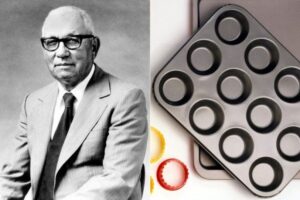 When Roy Plunkett went to work that day, his plan was to make a better refrigerator. Plunkett was a chemist who worked for a company named DuPont. It was a dream job for a 27-year-old man, just starting his working career. A plan had been forming in his brain as to how the refrigerator could be improved. The chemicals necessary were a gas named Tetrafluoroethylene and Hydrochloric Acid. He has gathered the chemicals together, but he wasn’t quite ready to start experimenting yet, so he cooled and pressurized the Tetrafluoroethylene gas in canisters overnight, planning to get started bright and early the next morning.
When Roy Plunkett went to work that day, his plan was to make a better refrigerator. Plunkett was a chemist who worked for a company named DuPont. It was a dream job for a 27-year-old man, just starting his working career. A plan had been forming in his brain as to how the refrigerator could be improved. The chemicals necessary were a gas named Tetrafluoroethylene and Hydrochloric Acid. He has gathered the chemicals together, but he wasn’t quite ready to start experimenting yet, so he cooled and pressurized the Tetrafluoroethylene gas in canisters overnight, planning to get started bright and early the next morning.
When Plunkett returned the next day, he found that there was no gas in the canisters. Oddly, the canisters weighed the same amount as when they were full, but nothing came out of them. Well, this was confusing!! Where did all the gas go? Now, Plunkett was intrigued, so he cut the canisters in half. During the cooling process, the gas had solidified on the sides of the canisters, creating a slick surface. I can only imagine what their thoughts were on that. They had to figure out what had happened. The use of the chemical was one thing, but curiosity about what had happened was more than Plunkett to stand to just let go.
According to the account in DuPont’s history annals, “Rather than discard the apparent mistake, Plunkett and his assistant tested the new polymer and found that it had some very unusual properties: it was extremely slippery as well as inert to virtually all chemicals, including highly corrosive acids. The product, trademarked as Teflon in 1945, was first used by the military in artillery shell fuses and in the production of nuclear material for the Manhattan Project.” Of course, these days, we all know about Teflon. The main use is in non-stick cookware. It has other uses, but that is the one we all would know, because Teflon became a household word. Any cook, chef, homemaker, or even bachelor, knows about Teflon cookware. It’s big part of cooking life.
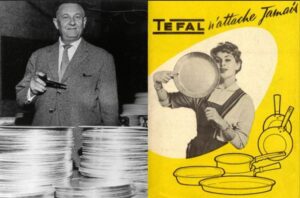 While cookware is the main thing that Teflon is used for, Plunkett wasn’t thinking of cookware when he invented it. In fact, it wasn’t until a decade after Plunkett sawed those canisters in half, that a French engineer named Marc Grégoire saw the cookware value and introduced “Tefal” pans…the first to be lined in Teflon. The funny thing is that the idea actually came from his wife. I suppose that the person who normally did the cooking in those days, would be the one to see the value in a non-stick finish. Before Tefal, Grégoire used Teflon on his fishing tackle to prevent tangling. The guys thought of fairly good uses, but Grégoire’s wife realized that the nonstick surface would be perfect for cookware.
While cookware is the main thing that Teflon is used for, Plunkett wasn’t thinking of cookware when he invented it. In fact, it wasn’t until a decade after Plunkett sawed those canisters in half, that a French engineer named Marc Grégoire saw the cookware value and introduced “Tefal” pans…the first to be lined in Teflon. The funny thing is that the idea actually came from his wife. I suppose that the person who normally did the cooking in those days, would be the one to see the value in a non-stick finish. Before Tefal, Grégoire used Teflon on his fishing tackle to prevent tangling. The guys thought of fairly good uses, but Grégoire’s wife realized that the nonstick surface would be perfect for cookware.
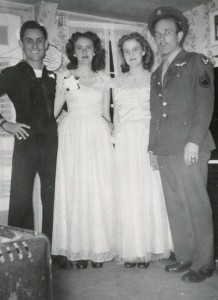
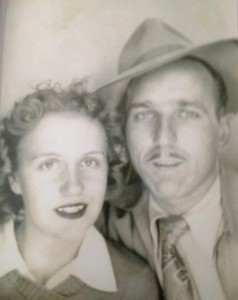 When my parents got married, it was not uncommon for there to be a number of years difference in ages. My mom’s parents were sixteen years different in age, and my parents were twelve years different in age. The first time Mom met Dad, she was a starry-eyed girl looking at a very handsome man for the first time, but somehow, she knew that he would be the one, and so he was. Of course, it would be a number of years later that they would actually marry, because she had some growing up to do. Nevertheless, she was just 17 years old when they did get married.
When my parents got married, it was not uncommon for there to be a number of years difference in ages. My mom’s parents were sixteen years different in age, and my parents were twelve years different in age. The first time Mom met Dad, she was a starry-eyed girl looking at a very handsome man for the first time, but somehow, she knew that he would be the one, and so he was. Of course, it would be a number of years later that they would actually marry, because she had some growing up to do. Nevertheless, she was just 17 years old when they did get married.
They took a honeymoon that took them to their new home in Superior, Wisconsin, and just ten months later they were new parents to Cheryl. Life was good. Mom was making new friends in her new home, mostly Dad’s family, which was fine, because she was a bit shy. In fact, her family has always been her friends, along with a couple of close girlfriends. She liked it that way. Better to have a close circle of friends and family, than a world of acquaintances. The years that followed brought four more daughters, Caryn (me), Caryl, Alena, and Allyn…in fairly close succession. The years also brought a move back to Mom’s hometown of Casper, Wyoming, because she really missed her family…Mom had six sisters (Evelyn 
 Hushman, Virginia Beadle, Delores Johnson, Bonnie McDaniels, Dixie Richards, and Sandy Pattan), and two brothers (Larry Byer and Wayne Byer). Being used to a big family with lots of activities and comradery, Mom had really missed her childhood home, but she also, always missed the family and friends she left behind in Superior, Wisconsin too. Dad missed his family too, but he knew that his bride needed to be close to her family, so he brought her home.
Hushman, Virginia Beadle, Delores Johnson, Bonnie McDaniels, Dixie Richards, and Sandy Pattan), and two brothers (Larry Byer and Wayne Byer). Being used to a big family with lots of activities and comradery, Mom had really missed her childhood home, but she also, always missed the family and friends she left behind in Superior, Wisconsin too. Dad missed his family too, but he knew that his bride needed to be close to her family, so he brought her home.
My parents’ story is a true love story, filled with respect for each other, and working toward a common goal. Their favorite place to be, was together. While they loved to travel, it really didn’t matter where they were, as long as they were together. Their life was their family, kids and grandkids. They rejoiced over each and every one of us. When the grandchildren, great grandchildren, and even great great grandchildren began to arrive they were reminded that these were the rewards of long life, and they knew that they were very blessed. They always taught their family to love the Lord, and to have faith in Him, no matter what the circumstances looked like. They taught us that God could always make a way, even when there seemed to be no way. They gave us 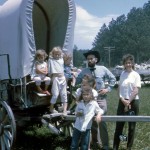
 strength to go on, even when things seemed to be falling apart…not that our lives fell apart much. We really did lead blessed lives, and I think it was the teachings of our parents that made that possible. I am so grateful for the parents that God blessed me with. While there is no marriage in Heaven, I know that they are celebrating the children, grandchildren, great grandchildren, and great great grandchildren that were born into their earthly marriage and having a blessed day.
strength to go on, even when things seemed to be falling apart…not that our lives fell apart much. We really did lead blessed lives, and I think it was the teachings of our parents that made that possible. I am so grateful for the parents that God blessed me with. While there is no marriage in Heaven, I know that they are celebrating the children, grandchildren, great grandchildren, and great great grandchildren that were born into their earthly marriage and having a blessed day.

